Google Ads Keyword Research Guide for 2025
One of the most complicated and essential parts of Google Ads is the keywords
Without the right keywords, your Google Ads will flounder, and you’ll struggle to get any kind of traction on the platform.
Choosing the right keywords, therefore, is crucial. And with the right strategy, process, and a little split testing, the keyword research process is key to helping you find strong keywords faster.
In this Hub chapter, we’re going to walk you through our step-by-step process, showing you exactly how to conduct keyword research for Google Ads here at GrowMyAds.
See our YouTube as well:
Why Do Keywords Matter for Google Ads?
Keywords are the center of everything that you’re going to do with your campaigns on Google Search Ads.
They tell Google which placements you want to bid on and what types of searches you want to appear in. (Keyword match types can help with that last part).
They give you more control over campaigns and help you show up in relevant searches, allowing you to display your ad in front of users who are searching for products, services, or brands like yours.
And while choosing keywords may seem straightforward, you need to be exceptionally strategic.
That means in-depth keyword research is needed to help you find high-intent keywords with strong enough search volume to get you visibility at a price that you’re interested in (or can afford) paying.
It’s not as easy as running an ice cream shop and targeting every ice cream related term that you can think of.
Maybe users will get annoyed if you show up in a “gelato” search result but don’t actually specifically sell gelato, and if you’re not careful to rule out “vegan ice cream” through negative keywords, you could have customers showing up who can’t be served.

How Specific Do My Keywords Need to Be?
This is an excellent question, and it’s one that our clients ask often.
We just briefly touched on why you don’t want to throw spaghetti at the wall to see what sticks when it comes to keywords. You want to avoid throwing in every single term that might be related to your product when you’re building an ad group.
That being said, there will be some trial and error. It may surprise you which keywords pop up as profitable with high rates of customer acquisitions.
Keyword match type is something to be aware of, too. There are three different keyword match types that allow you to tell Google how literal and exact you want to be. They include:
- Broad match— Google will assess the keyword and copy and may have your ad appear in searches similar to the keyword you’re targeting
- Phrase match— As long as your keyword phrase is used in a search, your ad can appear even if other terms are before or after that phrase
- Exact match— Your ad will only appear when someone searches for your exact keywords or an extremely close variant (close variants include things like misspellings, language differences, abbreviations, or reordered words that mean the same thing)
Match types are an important part of your strategy. Learn more about how to use them and factor them in by checking out our Keyword Match Types Hub.
What Types of Keywords Should I Be Targeting & When?
In addition to different keyword match types, there are also different categories of keywords that shape what sort of results users are looking for.
These are not formal categories that you can search for on Google; you’re not going to see a type designation listed in any research tool. Instead, this is an awareness of how different terms are often used by searchers and what they’re looking for when they use them.
Being intentional about keyword types means that you’re more likely to add the right keywords to your campaigns that will help you attract conversions, or to at least get users the landing pages that they’re trying to find.
High-Intent Commercial Keywords
High-intent, commercial-focused keywords are going to be the bread and butter of Google Ads. It’s what most advertisers utilize the platform for; they want to drive purchases or conversions like booked appointments as quickly as possible.
These are keywords that indicate that the searcher is actively researching a purchasing decision. They’re choosing a product or brand to go with, and they’re looking for options.
There’s a difference, for example, between someone searching for “how much do wedding venues cost” and “outdoor wedding venue Fort Myers.”
The first is simply about gathering general information, and the searcher may even just be curious. The second, however, is looking for something specific; this isn’t just an information-based search, they want to find a particular type of venue. They’re more likely to book.
High-intent keywords are often going to be more competitive and cost more than other types of keywords, but the quality of leads they can bring are often worth it.
Keep in mind, too, that you can use longtail, specific high intent keywords (like “outdoor wedding venue Orlando” instead of just “Orlando wedding venue”) to reduce competition and increase relevance.
Informational Keywords
Informational keywords typically are not going to be conversion-focused; people are looking for answers, not necessarily products or services.
Informational keywords might include examples like “how much does a wedding cost” or “what should I consider when booking a venue” instead of “outdoor wedding venue near me.” They’re often long-form and may be question-based. They’re typically used to create content like blog posts, webinars, and ebooks.
This means that they’re often not going to be a great fit when you want to drive purchases right away. They can be useful, however, if you’re running campaigns that are designed to promote resources like lead magnets that get users into the funnel initially.
You typically aren’t going to want to invest much ad spend into these keywords, but they may have a place in some ad funnels.
Your Branded Keywords
Ever searched for a specific brand or product and had an ad pop up— not just an organic search? (You can see an example of this in both Shopping and Text ads below from Blueair.)

This may seem redundant, but it can actually be part of a smart brand strategy. Bidding on your own branded keywords (which include brand names and branded product names) helps you to protect your home turf, so to speak, ensuring that you’re the first thing that shows up when customers are searching for you.
Competitors, after all, may be bidding on your brand keywords if you’ve got a well-established name in the industry. You definitely don’t want them to show up first, so allocating a small portion of your budget to ensure you’re ranking first may be worth it.
Your Competitors’ Keywords
The flip side of the above: You can bid on your competitors’ keywords, too.
Note: This generally is a strategy we recommend testing later on once your account is more mature and profitable already.
If you’ve got competitors with significant brand name awareness, bidding on their keywords gives you a chance to snag some of their traffic and their momentum. You can leverage that awareness for yourself, and you can also use “brand vs. brand” keywords or copy that compares your product to theirs to increase the odds of a click.
Let’s look at that Blueair example again. Look down at the bottom, at Alen vs. Blue Air Purification Systems. It makes an appealing case for why you should at least click and consider their product instead.

How to Conduct Google Ads Keyword Research with Keyword Planner
Keyword research can be a time-intensive process, but our best recommendation is to conduct this research manually and intentionally.
By that, we mean you want to really assess each keyword that you add to your campaigns instead of just running a generic search and adding all the recommendations to your keywords lists.
For this post, we’re going to look specifically at how to conduct keyword research with Google’s Keyword Planner. This is a free tool available for all advertisers, and you can find it by going to your Google Ads dashboard and looking under “Tools” and then under “Planning.” (You can also find Keyword Planner by clicking here.)

Getting Started with Google’s Keyword Planner
Google’s Keyword Planner lets you start in one of two ways. You can either start with a few keywords of your choice, or let Google pull keywords from your site.

We start with seed keywords. This allows you to prioritize different high-value products or services instead of relying on Google to put the puzzle pieces together for you.
Let’s say that you’re selling customizable, easy-to-install closet systems. You search for terms like “closet systems,” “California closets,” and “customizable closets.” You see the following results:

There are plenty of keywords here that you can sort through.
Choosing Your Keywords for Google Ads
There are a few things to consider as you’re doing reviewing the terms that have appeared:
- Look at relevance. When you’re reviewing the keyword list, the most important thing you can do is consider search intent and potential relevance for your campaigns. Someone who is searching for “closet system with drawers” wouldn’t love to find an ad that only had a closet system with shelves and hangers.
- Assess types of keywords. We’ve already covered the different types of keywords; make mental notes of good keywords that fit your campaigns’ needs. This particular search, for example, has a ton of branded keywords with brands like Lowes, Closetmaid, Elfa, Home Depot, and more.
- See how the keyword has trended over time. Google’s Keyword Planner shows you how a keyword has trended in popularity both over the past three months, and in a year-over-year change.
Rapid growth indicates it is worth paying attention to, but it also means you’ll want to monitor it carefully; it may fall out of trend quickly, too. Keep an eye on keywords that seem to have instability in monthly searches.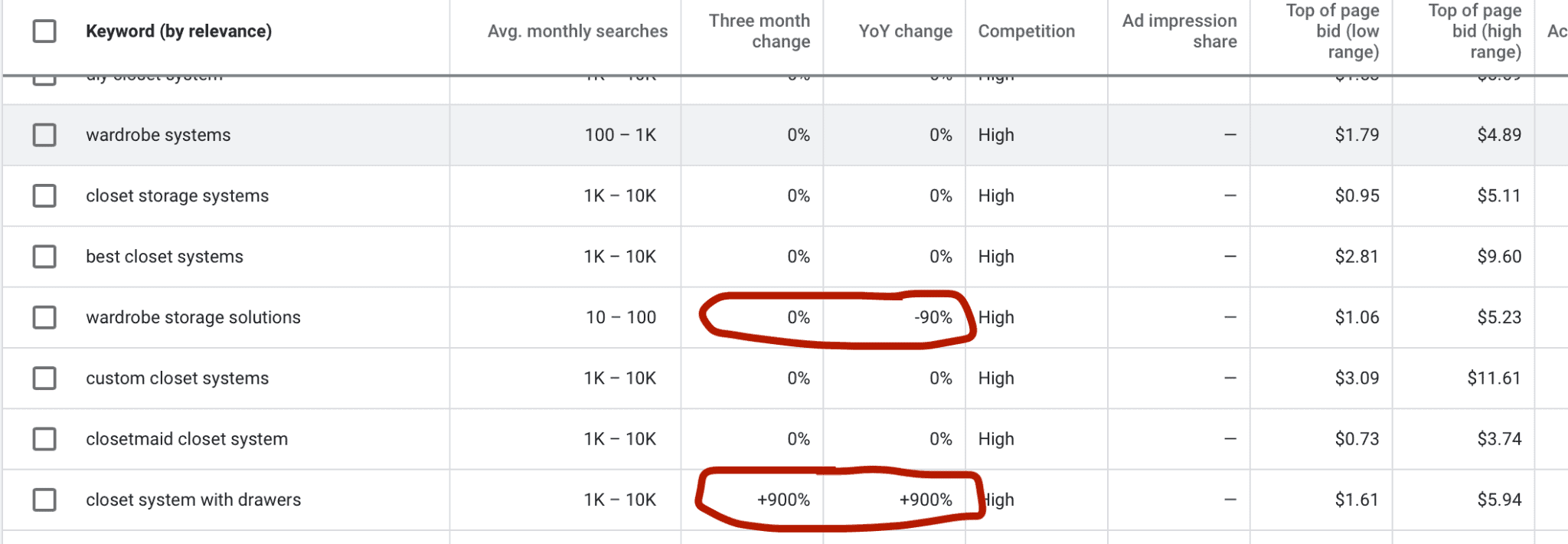
- Look at estimate CPC ranges. Some keywords are going to cost a lot more to rank well for. “Custom closet systems” costs over $11 for a top of the page bid, for example, and “California Closets” costs $26 while “closet shelving systems” costs around $4.
In many cases, bid is a signal for intent. Higher bids are often aligned with higher search intent, because advertisers are getting results using those keywords.
You don’t want to automatically rule out higher-cost keywords because they can bring in higher-value leads, but you want to be aware of those costs.
Also, these estimate CPCs are “estimates” – some keywords might appear too high but when you actually add them to your account to test you’ll notice you can get cheaper clicks depending on match type.
Narrowing Down Your Keyword Lists with Filters
As we conduct keyword research in Google Ads for our clients, we use filters and other criteria to make our search more effective and productive, increasing the chance of finding relevant keywords for their campaigns.
This is a four-step approach. Let’s go through it.
Narrow Down Location
When you’re doing keyword research, the default state through the Keyword Planner will be to show you the history of certain keywords and their performance for the country that you’re in.
If you’re targeting customers throughout the entire country, great! In some cases, though, businesses may only want to reach audiences in specific geographic regions.
If that’s the case, you want your keywords to reflect the search terms your specific audience is using. Dialect can play an important role.
To get data on the specific regions you’re interested in, find the location above the keyword search terms. Here, it’s “United States.” Click to edit it.

You can then enter the country, state, city, or region that you want to research. You can add multiples at once to cover your bases as needed.

Choose Which Platforms You Want Data For
Next to the language filter (which is next to the location filter), you’ll see an indicator that just says “Google.”

Here, you can choose whether you want to do keyword research just for Google’s ad placements, or if you want to conduct keyword research for both Google Ads and the placements that will appear in the search network.
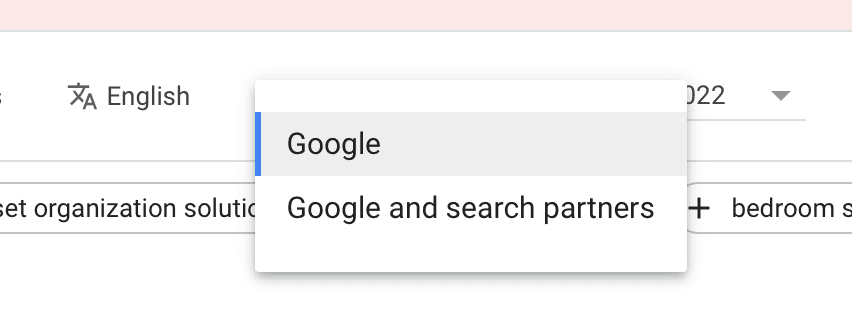
This all comes down to your campaigns. If you’re focused most on getting on-platform placements, you can keep it to just “Google.”
Use Filters to Find High-Potential Keywords
Next, you can use Google’s filters to find keywords that align with specific criteria that you’re looking for to create strong, high-performing campaigns.
You can see the “Add Filter” button right above the keyword list. Click on that, and it will open a drop-down menu.

While you can get plenty creative here, one filter we consistently use is to set a filter for average monthly searches. We want 30 or greater monthly searches per keyword in most cases. In our experience, if there’s not more than one impression per day, it’s typically not worth targeting.
And while average monthly search data isn’t 100% reliable, this is a good place to start.
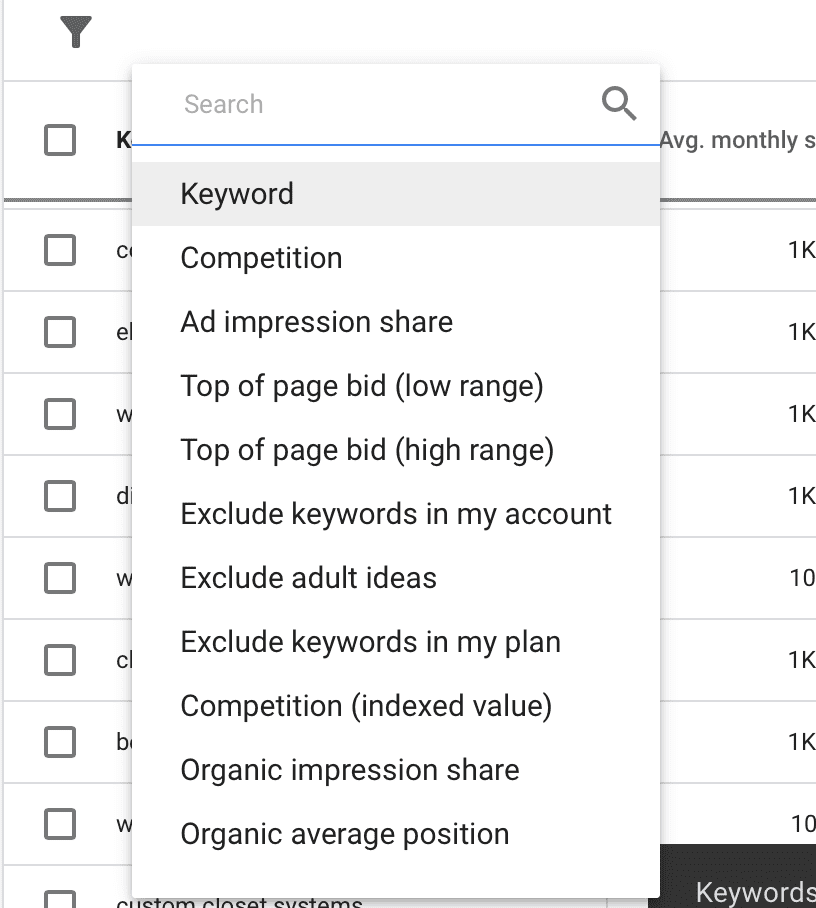
Refine Keywords Through Google
Last but most definitely not least, we’ve got the “refining keywords” tool that’s found on the right side of the Keyword Planner.
When you click on it, you’ll see a drop down menu that allows you to choose which keywords you want to include or exclude on the list.
These options will vary heavily depending on your chosen keywords. For restaurants or catering, they’ll feature cuisine options; for our closet system keywords, it will focus more on amenities and other features.
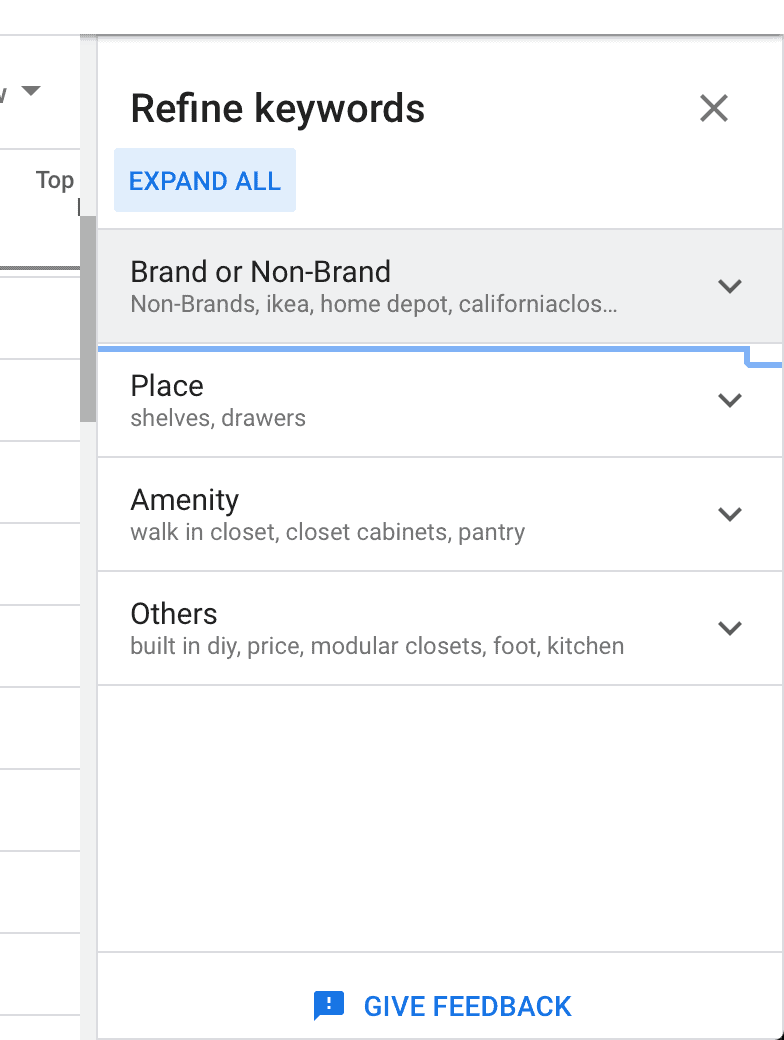
Use this to root out keywords that are not a fit for your brand so it’s easier to find those that are.
If we’re selling a high-cost closet system that’s comparable to California Closets, we’re not going to want to show up in search results for people looking for significantly lower-cost options like those from Ikea, Walmart, and Target. And if we’re selling customizable options, Amazon is out, too.
Uncheck all of these boxes to remove the search terms from the list you’re reviewing.
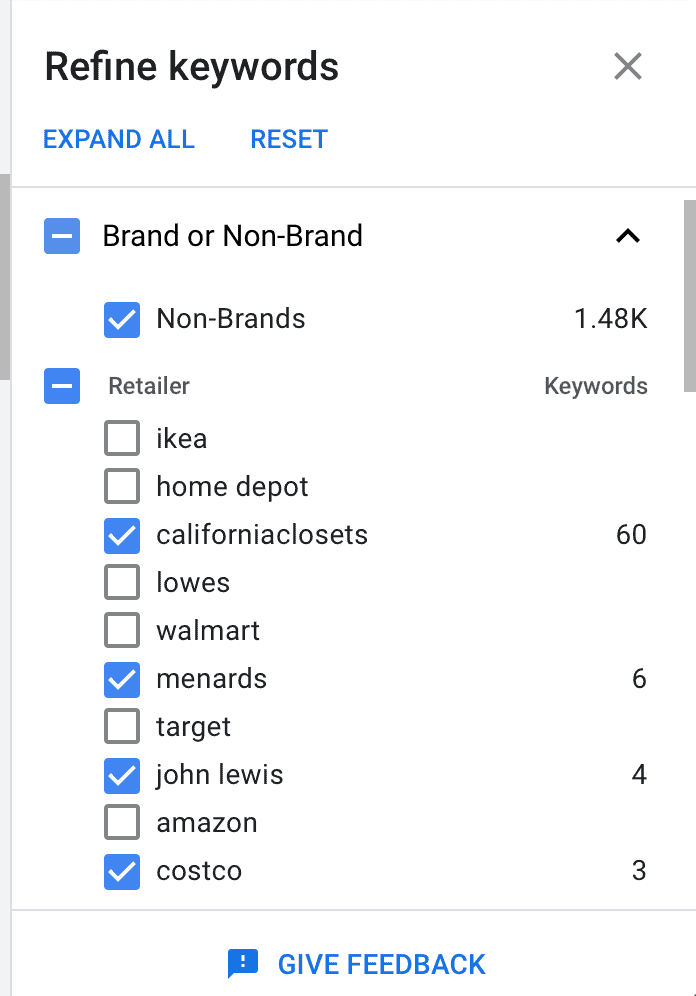
Generating & Downloading Keyword Lists
Alright! We’ve nearly got a semi-final list here, and now you just need to get them connected to your campaigns.
To add keywords to your list, you can check the checkbox next to the keywords of your choice. Once you do, look at the blue header above. It will tell you how many keywords you have selected, and you’ll choose which ad group to connect them to and what match type you want to set them to. You can then “Add keywords to create plan.”

As you’re scrolling, you may also find plenty of negative keywords you want to add to your campaigns.
You can also use the refining process to single out keywords you don’t want to rank for. Highlight these keywords, and then click “More” in the blue header to find “Add as negative keywords.” You can choose your match type here, too.
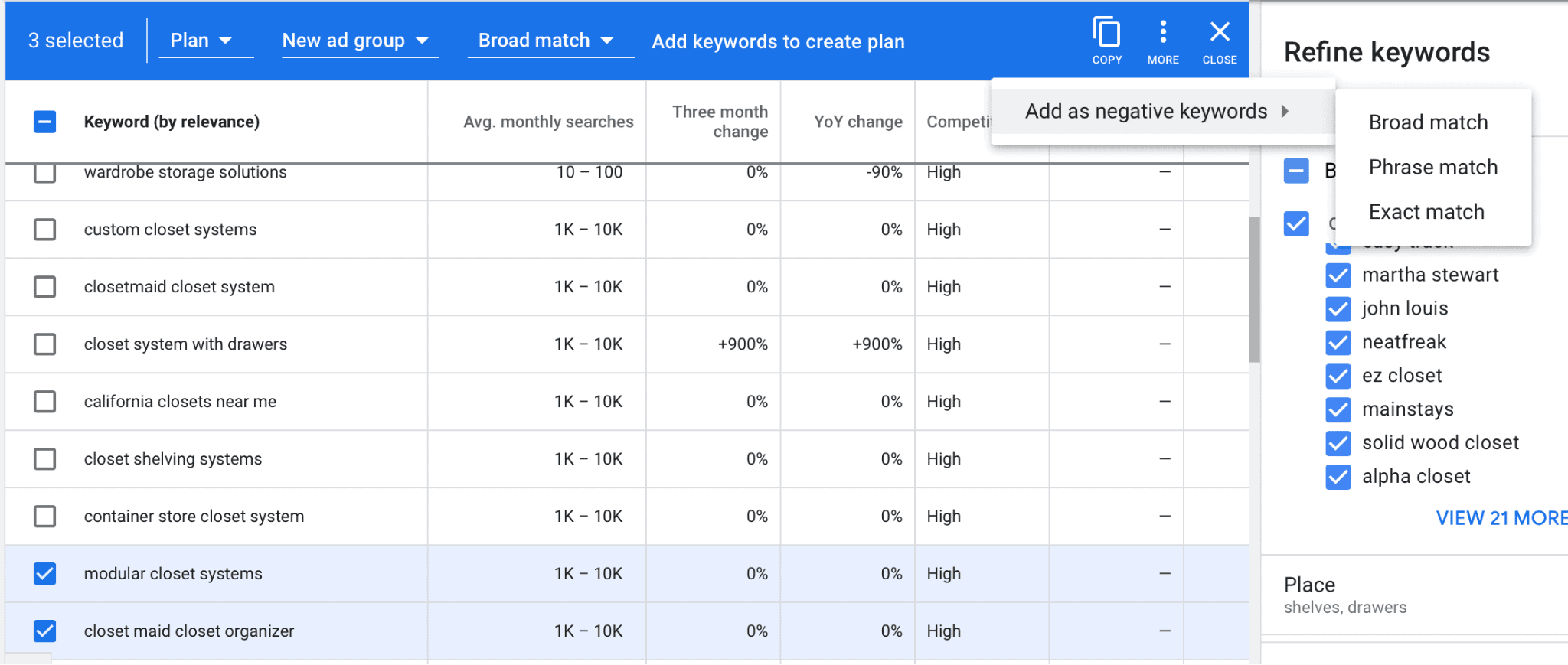
Our preferred method is to actually download the terms to an Excel or Google Sheets folder. They’re easy to copy and upload later. You can do this by finding the “Download” icon in the top right hand corner and choosing either .CSV or Google Sheets.

One More Manual Search
Last step here! We promise!
After we’ve conducted our keyword research with Google’s Keyword Planner, we like to go one step further. We’ll actually enter in some of those keywords into Google and see what other suggestions pop up.
When we type in “Custom Closet,” for example, options like “custom closet Orlando,” “custom closet companies,” and “custom closet systems” are all good high-intent keywords. We may add those to the list if they weren’t already. You can research these keywords in the Keyword Planner to get an idea of their potential cost, reach, and overall value.
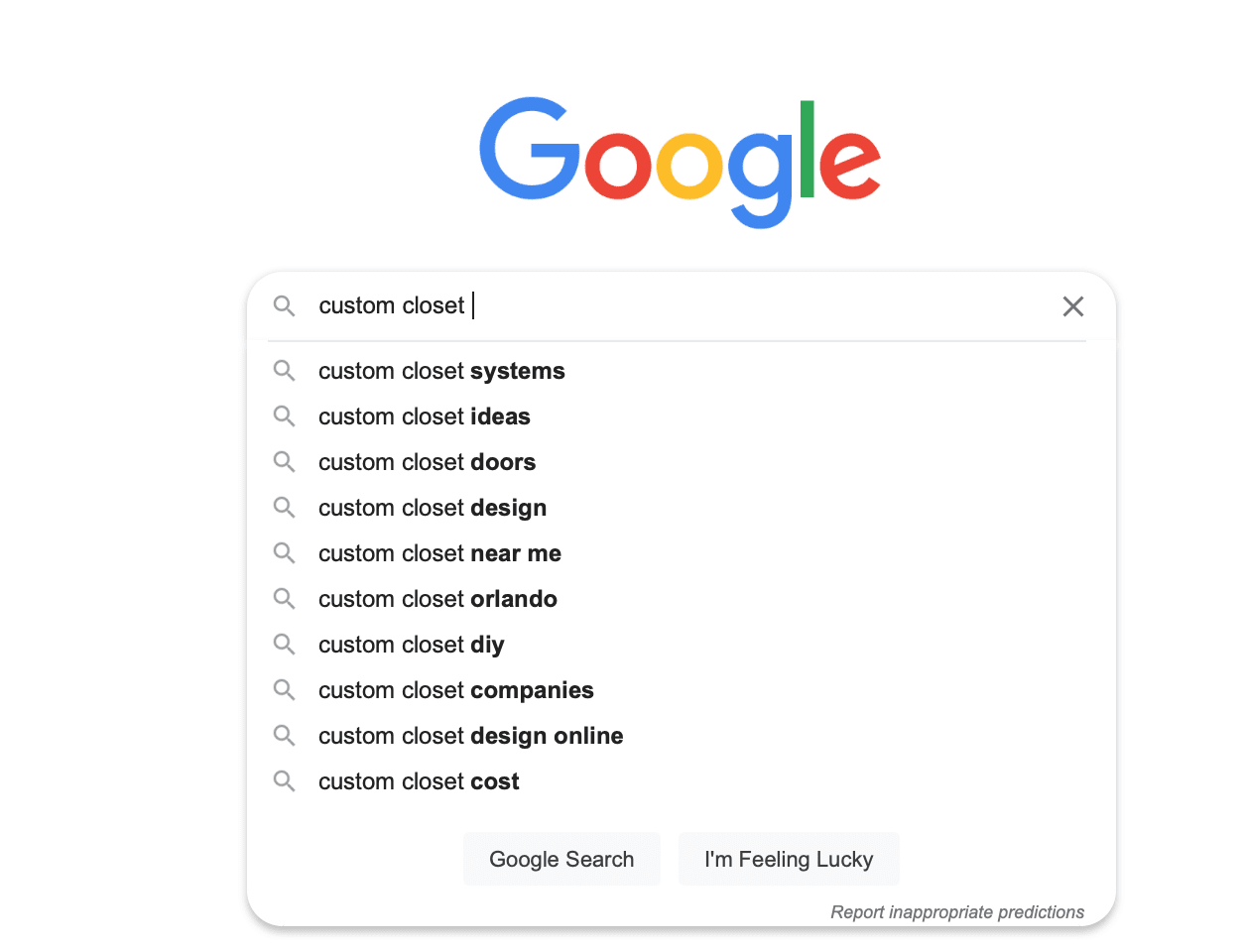
What About Third-Party Keyword Research Tools?
There are plenty of keyword research tools available that can streamline the process or garner additional insight for advertisers.
We prefer to manually conduct keyword research ourselves and we use the Google Keyword Planner, but other platforms do have unique benefits.
Semrush, for example, has a great “questions” feature. You can see questions-based keywords, which can help you find informational keywords if you’re looking to promote resources.
Ahrefs offers keyword insights not only for Google Ads, but also for Bing and YouTube Ads, too. If you want to run multiple campaigns at once, this may be a good option to consider.
And SpyFu has exceptional tools for fast competitor analysis. If you want to know which keywords your competition is bidding on, they can help.
So it’s up to you. We still firmly believe in always being strategic about manual keyword analysis, but third-party tools can be beneficial.
Keyword Research Mistakes to Avoid
Now that we’ve shared our keyword research process, we want to go over a few mistakes we see so many advertisers fall into.
These are the common pitfalls of Google Ads keyword research you want to avoid:
- Delaying getting started due to overwhelm. Trust us— just get started. Keyword research needs a strategy, but it shouldn’t take forever and span multiple meetings.
Do your research, but then start spending and getting data. Because at the end of the day, even the best research is nothing more than a best guess until you see what really works for you. - Bidding on any relevant keyword that seems to match your industry. You need to choose keywords that align with what you’re selling. Shoehorning keywords won’t work.
- Ignoring the bid cost, or counting out high-cost keywords. Higher bid costs can mean that there’s higher search intent, or that the keyword can deliver higher-quality clicks. That doesn’t always mean that those customers are right for you, however.
Maybe I don’t want to pay $26 a click for that California Closet keyword if I really have a DIY modular solution that isn’t anywhere near what that audience is looking for. It doesn’t matter if they have a higher budget if they won’t be interested in my product.
Don’t rule out higher-cost or lower-cost keywords by price alone until you see the results, so long as you can afford them in the first place.
What If I’m On a Tight Budget?
We’re firm believers that every advertiser— at every budget— can take full advantage of the Google Search Ads platform.
Those with tighter budgets, however, have a little less wiggle room, however. This means adapting different strategies to get the most out of the ad spend that you do have.
We recommend that smaller spenders start with long-tail exact match keyword terms. This will give you lower volume, but a higher chance of converting. The data will also be more clear so you can see which keywords are really driving results.
As you’re getting results, you can then expand into broader terms to expand your campaigns more.
Final Thoughts
Keyword research is imperative to the success of your campaigns, but ultimately running tests and keeping a close eye on your analytics will matter just as much. A hands-on Google Ads agency can help you with both.
Don’t forget that keyword match types and negative keywords play just as equal roles in what searches you show up in. Keep this in mind when adding keywords to your Google Ads campaigns.
Looking for more tips to optimize your Google Search Ad campaigns? Check out our entire Google Search Fundamentals Hub.



 Google Search Ads Statistics & Benchmarks
Google Search Ads Statistics & Benchmarks
